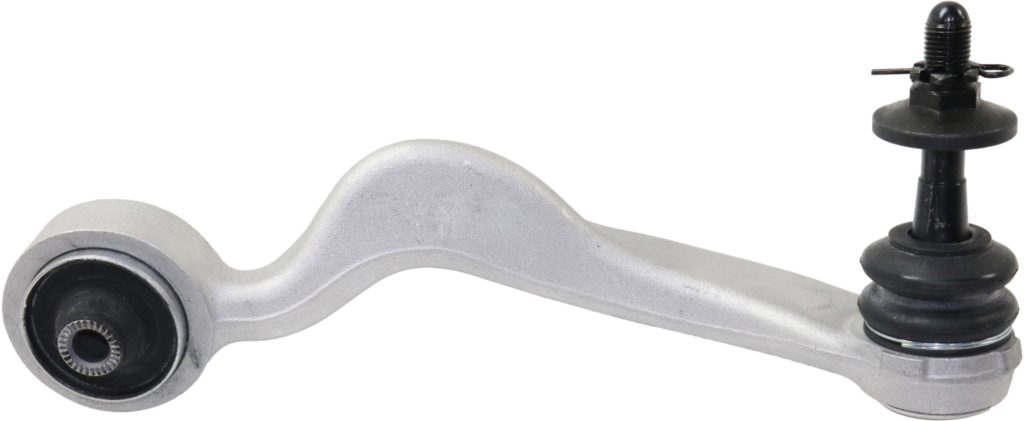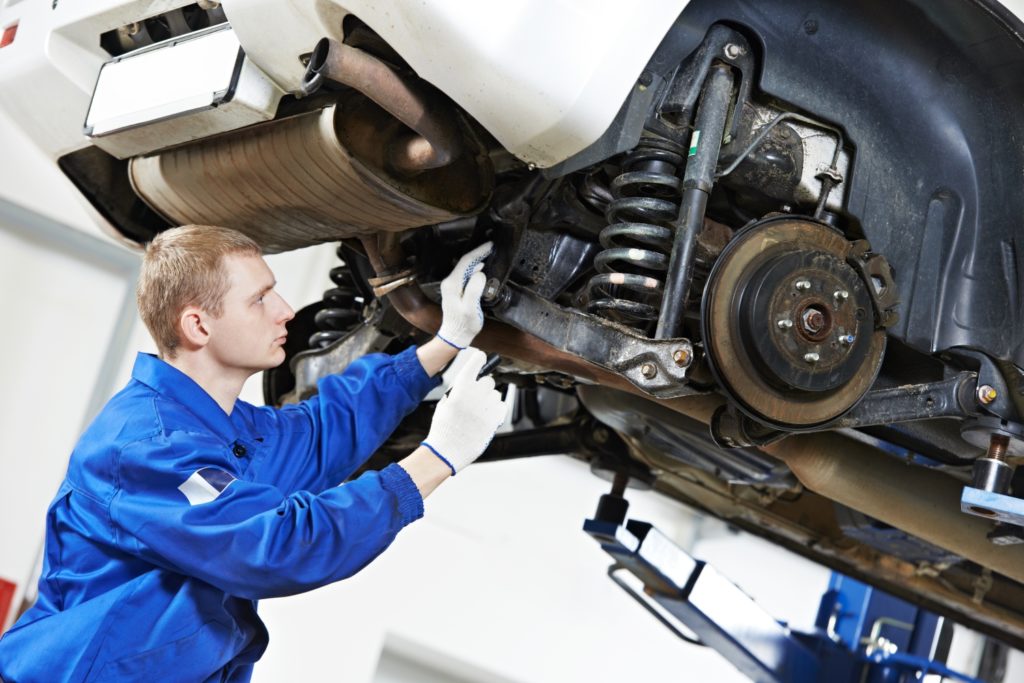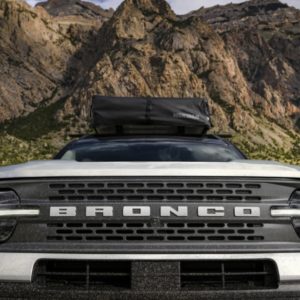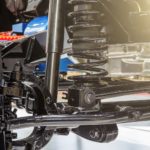Your car’s front suspension is made up of a variety of components working together to provide adequate ride comfort. The suspension also keeps your car’s tires in contact with the road.
Because suspension repairs are so common, it’s helpful to be able to understand how a typical front suspension works. That way, you have some knowledge to fall back on the next time your car needs front end work.

How Does a Front Suspension Work
Front suspension operation is pretty straightforward. All suspension systems include springs and dampers of some kind. When the vehicle travels down the road, the springs support the vehicle and absorb impacts from bumps, while the dampers control the spring oscillations.
The video below explains more about how suspensions work:
Some of the Most Common Types of Front End Suspensions
There are many different front suspension designs in use today, ranging from MacPherson strut to solid axle. The most common arrangements include:
MacPherson Strut
These days, the most common type of front suspension system is a MacPherson Strut. Two strut assemblies (one on each side of the vehicle) are the focal point of the design.
A typical MacPherson strut assembly contains a damper, a coil spring, and a top mount with an integrated bearing. Each strut assembly mounts between a steering knuckle and the car’s body. The struts act as a structural part of the suspension system, and the top mounts provide pivot points for the vehicle’s steering.

Modified Double Wishbone
The modified double wishbone (named for the strut’s wishbone-shaped bottom portion) is another type of strut suspension. With this design, upper ball joints, rather than the strut mounts, provide pivot points for the car’s steering system.
Modified Strut
There’s also another, less common type of strut suspension called a modified strut. Unlike other types of strut systems, the modified design does not incorporate the coil spring into the strut assembly. The coil spring sits on the lower control arm instead.

Short/Long Arm (SLA)
Many rear-wheel drive vehicles have a short/long arm (SLA) front suspension. With this design, each side of the vehicle contains a coil spring (with a shock running through the middle) positioned between two control arms. Because the upper control arms are longer than the lower ones, the setup is known as a short arm/long arm front suspension.
Solid Axle
Some four-wheel drive vehicles use a solid axle front suspension. The layout uses two leaf springs (one on either side of the vehicle) that serve as a mounting location for the front differential (axle) assembly. A pair of shocks connect between the differential housing and the vehicle’s frame.
Torsion Bar
Instead of using leaf springs or coil springs, a torsion bar suspension relies on a pair of torsion bars (one on each side of the vehicle) to absorb road shocks and support weight. Each torsion bar connects to a lower control arm at one end and the vehicle’s frame at the other.
What are the Parts of a Front Suspension (MacPherson Strut Design)?

There are many different kinds of front suspension designs in use today. Each type of suspension contains a unique combination of distinct components.
Because the most common type of suspension is a MacPherson strut, we’re going to focus on the front end parts that are common to that design.
A typical MacPherson strut front suspension system includes the following components:
Strut Assemblies
There is one front strut assembly on either side of the vehicle. Each one acts as a structural part of the suspension and provides an upper pivot point for the car’s steering.
A typical MacPherson strut assembly contains a damper mounted inside of a coil spring. The coil spring absorbs road shocks and supports the vehicle’s weight, whereas the damper limits the oscillations from the coil spring.
The strut assembly also contains an upper mount, which includes a bearing that allows the strut to rotate, and a dust boot that protects the damper from dirt and debris.
Control Arms and Ball Joints
Control arms allow the suspension to move up and down when traveling over imperfections in the road. Each control arm has bushings that allow it to move with minimal friction.
A typical control arm includes a ball joint that connects the control arm to the steering knuckle. The ball joints also act as lower pivot points for the steering knuckles when the driver turns the car’s front wheels.

Steering Knuckles
There is a steering knuckle behind each of the car’s front wheels. Each steering knuckle connects to the bottom of a strut assembly at one end and a ball joint at the other end. On most vehicles, the outer tie rods attach to the sides of the knuckles, as well.
The steering knuckles also provide a mounting location for the wheel hubs, which support the wheels and tires. When the driver turns the steering wheel, the tie rods pull or push on the steering knuckles, causing the wheels to move in or out.
Sway Bar and End Links
Most vehicles have a type of torsion spring, referred to as a sway bar, that connects to both lower control arms. When the vehicle is cornering, the sway bar twists to prevent body roll and improve handling. The sway bar also adds an extra level of stability when traveling over imperfections in the road.
At each end of the sway bar, there’s an end link that attaches to the control arm or strut assembly. Also, the sway bar has bushings at the locations where it’s affixed to the vehicle’s frame.
The videos below explain how the various part of a strut suspension system work together:
How is a Front End Suspension Diagnosed?
Common symptoms associated with worn-out front suspension components include:
- Unusual noises from the undercarriage
- Abnormal tire wear
- A harsh ride
- Front end shimmy
- Reduced steering performance
Most professional technicians will begin their diagnosis of the steering system by duplicating the customer’s concern via a road test. From there, they will usually put the vehicle on a hoist to perform a visual inspection.
If there aren’t any visible problems, the technician will then typically move forward to using one or more diagnostic strategies to pinpoint the problem.
For example, suppose the customer’s complaint is a clunking noise while driving over bumps. In that case, the technician may use a pry bar to check the various suspension components for an excessive amount of movement that could lead to strange noises.

Benefits of a Well-Maintained Suspension
Keeping your suspension well-maintained results in better handling, increased braking power, and improved fuel efficiency, among others.
Better Ride Comfort and Handling
A well-maintained front suspension ensures better ride comfort, as the system absorbs shocks and vibrations to ensure a smoother ride.
You can also expect improved handling and stability if you keep the suspension well-maintained because it is designed to support the vehicle’s weight.
Even Tire Wear
The front suspension helps distribute the vehicle’s weight evenly across the front tires to prevent uneven tire wear, thus extending your tires’ lifespan.
Improved Braking
A well-maintained front suspension also improves braking performance, reduces stopping distances, and enhances safety. The system ensures proper weight transfer during braking to allow for a more efficient brake pad-to-rotor contact.
Increased Fuel Efficiency
Lastly, a properly functioning front suspension system improves fuel efficiency because it ensures optimal tire contact with the road and reduces rolling resistance.
Get High-Quality Front Suspension Replacements Online
Faulty front-end suspension components can cause your vehicle to ride rough and even cause steering issues. Aside from making your vehicle’s ride feel harsh, faulty parts like control arms, strut assemblies, or steering knuckles can even affect you and your passenger’s safety. You should replace any faulty components immediately so that you can have full control over your vehicle’s steering. Good thing CarParts.com lets you shop for the right parts in just a few clicks.
CarParts.com is a trusted source when it comes to replacement parts for a wide range of makes and models. We have front suspension components from the leading aftermarket manufacturers. These parts are made to OE standards and specifications, ensuring precise fit and function.
Aside from reliable performance, you can also expect fast shipping thanks to our strategically located warehouses. Shop for control arms, strut assemblies, and steering knuckles here at CarParts.com today!
Any information provided on this Website is for informational purposes only and is not intended to replace consultation with a professional mechanic. The accuracy and timeliness of the information may change from the time of publication.





























